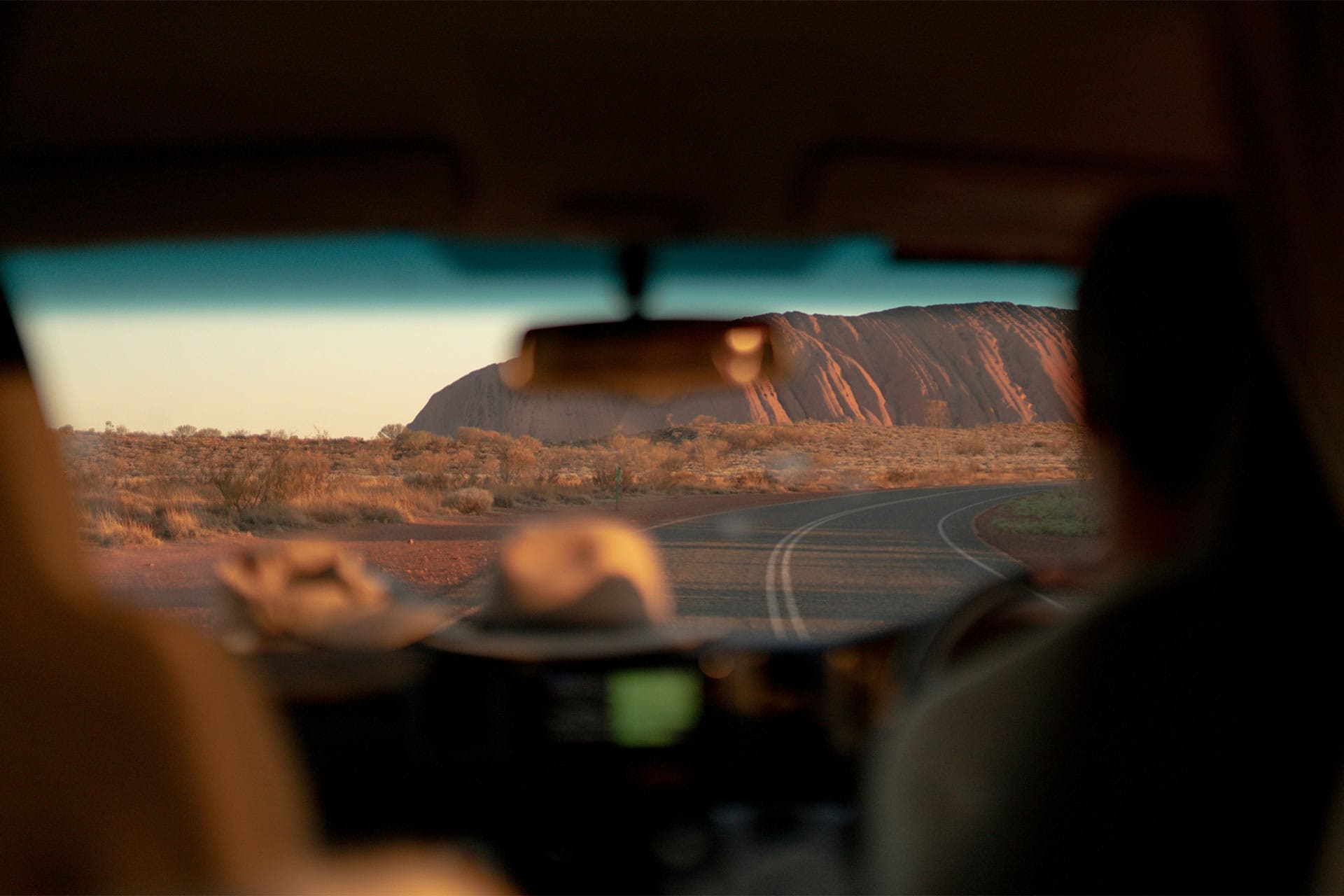Looking for the best Northern Territory road trips? Have an incredible time on one of these epic adventures!
Northern Territory road trips allow travellers to experience all the diversity and wonders that this remarkable Australian state has to offer.
There are lush swimming holes with turquoise waters like Bitter Springs and Katherine Hot Springs.
There are wild natural wonders like giant Termite Mounds in Litchfield National Park, the sacred monolith of Uluru, or the precariously placed boulders of Karlu Karlu.
You can find towering canyons like Ormiston Gorge or Redbank Gorge in the West Macdonnell Ranges, or Kings Canyon near Uluru.
There are famous landmarks and hidden gems that lie off the beaten track.
The Northern Territory also has Aboriginal people and communities whose culture dates back at least 65,000 years.
Whether you want to tour an Indigenous art gallery in Arnhem Land, or grab a beer at a country pub in Tennant Creek, the Northern Territory is full of culture, nature, and fun things to do.
These road trips are amazing because they allow for extended exploration of this incredible state. In your own car, you can soak in the landscape, plan your own itinerary, and take your time visiting different local attractions.
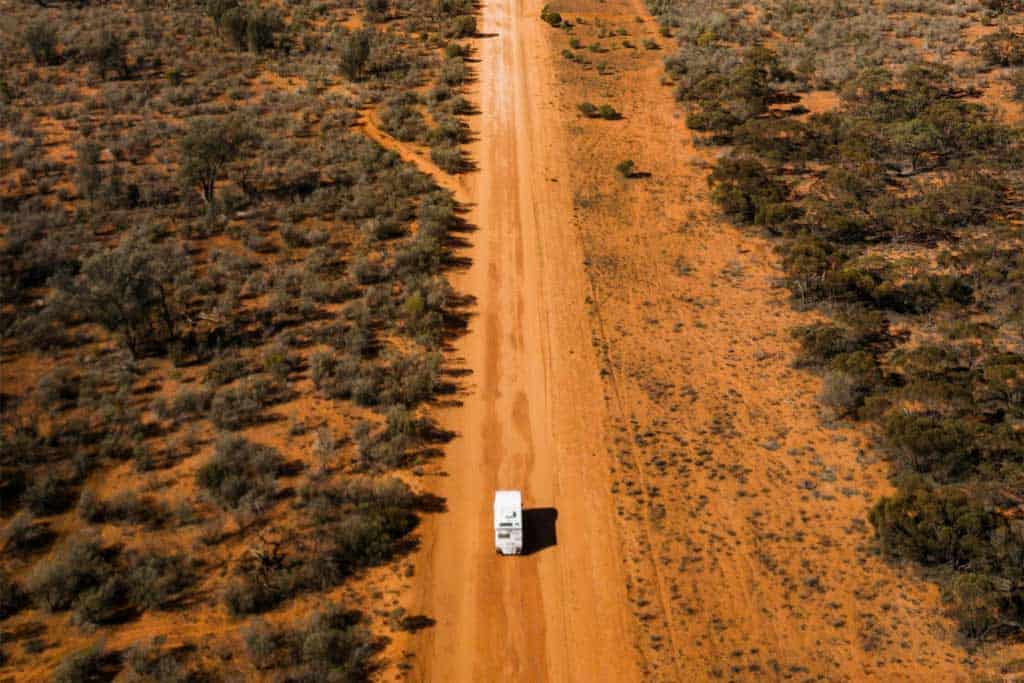 Road trips are an amazing way to explore the Outback!
Road trips are an amazing way to explore the Outback!
8 Best Northern Territory Road Trips
Most travellers will likely start their road trips in Darwin or Alice Springs. These are two of the main travel hubs where you have amenities like hotels, rental car offices, and well-connected airports.
Darwin is the perfect starting point for any road trips in the Top End. These destinations may include Litchfield National Park, Kakadu National Park, Katherine and Nitmiluk National Park, and Arnhem Land.
Alice Springs is the main starting point for a road trip in the Red Centre. Popular destinations here include Uluru, Kings Canyon, and the McDonnell Ranges.
Of course, you can also do road trips between Darwin and Alice Springs, which will bring you through the heart of the Northern Territory. In this case, you may be able to hire a car in one place and drop it off in the other.
So take all of these road trip ideas as inspiration, and be sure to do your own planning and preparation before you start your adventure.
The best way to get around is to rent a car and explore on your own! We recommend Rental Cars, which has the largest range of vehicles for the best value on the market.
Kakadu National Park
- Recommended time frame: 3-5 days
- Total distance: 600–800 km round trip (from Darwin, loop through Kakadu National Park, and back)
- 4WD required? Only for certain areas of the park like Jim Jim Falls, Twin Falls, Maguk Campground
As the second largest national park in Australia, Kakadu National Park measures almost 20,000 square kilometres.
This vast expanse of wilderness showcases the wild beauty of Australia’s Top End. And it’s only a 2.5 hour drive from Darwin!
Many visit Kakadu National Park as a day trip from Darwin, but we recommend spending 3-5 days road tripping around this magnificent park.
How you decide to explore within Kakadu National Park is totally up to you.
We definitely recommend checking out the incredible rock art at Ubirr and Nourlangie Rock, and learning about Indigenous culture at Bowali Visitor Centre.
For some of the top waterfalls, head to Motor Car Falls, Gunlom Falls, Maguk Falls, Twin Falls, or Jim Jim Falls (some of which may require a 4WD to access).
Other top things to do on a Kakadu National Park road trip include spotting crocodiles at Cahills Crossing, cruising the Yellow Water Billabong at sunset, flying over the park in a scenic flight, and discovering Indigenous culture at the Warradjan Cultural Centre.
Visit the official website for Kakadu National Park to learn more about the best things to do in this stunning national park.
Litchfield National Park
- Recommended time frame: 1-2 days
- Total distance: 300–400 km round trip (from Darwin, loop through Litchfield National Park, and back)
- 4WD required? Only for certain areas of the park like the Lost City, Surprise Creek Falls, and Sandy Creek Falls
An alternative to driving through Kakadu National Park is Litchfield National Park.
Litchfield is much closer to Darwin at just an hour from the city. Litchfield is also much smaller than Kakadu, making it an easier road trip to tackle if you’re short on time.
You can easily explore the highlights of the park in one day, though 2 days is better! This gives you more time to enjoy the lush natural beauty without rushing.
Must-sees in the park include Florence Falls, Wangi Falls, and Buley Rockhole. All offer a majestic cascade, a refreshing swimming hole, and a glimpse into the rugged Northern Territory scenery.
Florence Falls and Wangi Falls also have their own campgrounds if you are staying overnight.
Tolmer Falls is another amazing waterfall, though it doesn’t have an accessible swimming hole. The Magnetic Termite Mounds are also a wild expression of nature that you can see on your Litchfield road trip.
Check the Northern Territory government website for current park conditions and alerts!
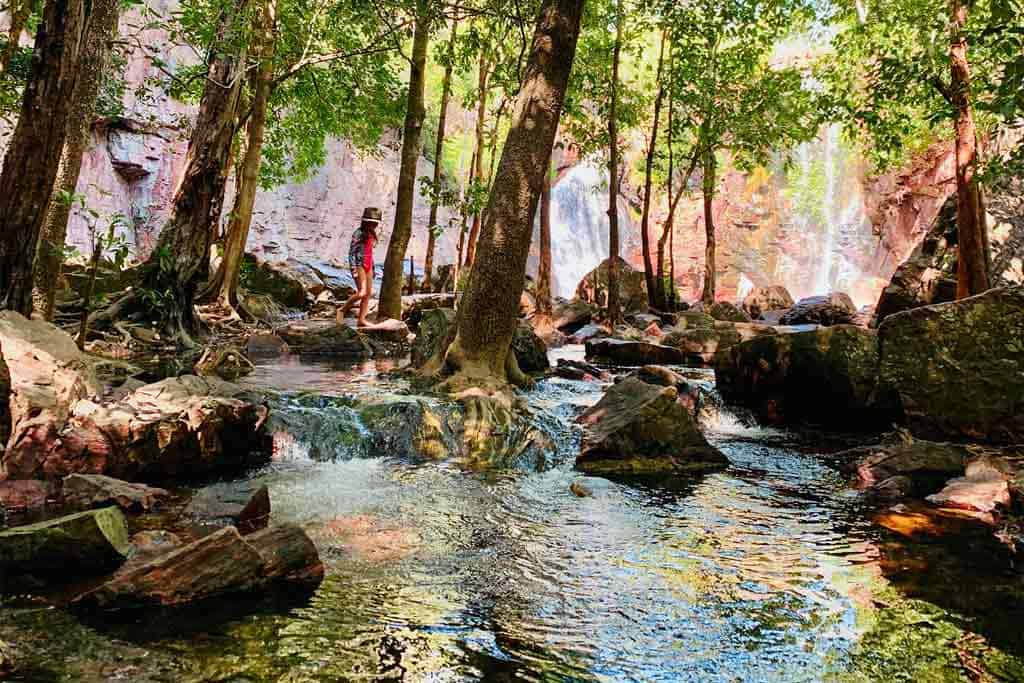 Serenity at Wangi Falls
Serenity at Wangi Falls
Arnhem Land
- Recommended time frame: 5-10 days
- Total distance: 1,000 to 2,000 km (round trip, depending on route)
- 4WD required? Yes, and a permit for access to Aboriginal land from the Northern Land Council (NLC) is also required
For the best insight into Indigenous culture, land, and history in Australia, plan a trip through Arnhem Land in the Top End.
You can easily start this drive in Darwin or Katherine, and extend the trip for a few days or a few weeks depending on how much time you have.
Start with a drive through Kakadu National Park along the Arnhem Highway.
Stop at Ubirr or Nourlangie to see the ancient Aboriginal rock art before continuing past Cahills Crossing into Arnhem Land. Make sure you check the tide times before crossing, as the river can be treacherous at high tide.
Then explore Gunbalanya, where you can check out hand-crafted artworks at the Injalak Arts Centre.
For a lovely insight into the rich culture of the Aboriginal coastal lands, explore Maningrida. Here you can join traditional cultural tours, do some amazing fishing, and visit the Maningrida Arts and Culture Centre.
Other places to visit in Arnhem Land include Ramingining & the Arafura wetlands, where you can spot abundant wildlife in the protected waterways, or Nhulunbuy, where you can visit pristine beaches on the Gove Peninsula and learn about Yolŋu culture.
Read next: The Ultimate 7 Day Darwin Itinerary, NT, Australia
Katherine and Nitmiluk National Park
- Recommended time frame: 3-5 days
- Total Distance: 600-900 km (from Darwin, down to Katherine and Nitmiluk National Park, return to Darwin)
- 4WD required? No, unless you want to go beyond Katherine Gorge and see some more remote areas
Katherine and the surrounding Nitmiluk National Park is a highlight of any Northern Territory road trip itinerary!
Most people start this journey in Darwin and then drive to Katherine along the Stuart Highway.
You can easily stop at Litchfield National Park along the way if you want to combine some of these road trip ideas.
Upon arriving in Katherine, relax in the soothing Katherine Hot Springs before exploring the highlights of the area.
Nitmiluk Gorge (Katherine Gorge) is the crown jewel. Here you can go for canoe or kayak rides, boat tours, or scenic helicopter rides to get the best views of the canyons filled with water from the Katherine River.
Other things you can do if you have time include the Katherine Outback Experience or splashing in the gorgeous swimming hole at Edith Falls.
 Don’t miss Katherine Gorge in the Northern Territory.
Don’t miss Katherine Gorge in the Northern Territory.
Darwin to Alice Springs
- Recommended time frame: 4-6 days
- Total distance: 1,500 km
- 4WD required? No, the Stuart Highway is fully sealed
Drive through the centre of Australia with an epic road trip from Darwin to Alice Springs!
As Darwin and Alice Springs both have international airports, you can easily start this road trip in one location and finish in the other without doing a return trip.
Darwin to Alice Springs takes you through the heart of the Australian Outback along the Stuart Highway.
On the way south, stop in Litchfield or Katherine along the way to soak up some of the Top End natural beauty. The Katherine Hot Springs will feel like heaven on this massive road trip!
Other iconic landmarks where you can break up the drive to Alice Springs include the classic Daly Waters Pub, the Outback town of Tennant Creek, the refreshing waters of Mataranka Hot Springs or Bitter Springs, and the unique rock formations of Karlu Karlu (Devils Marbles).
Once you make it to Alice Springs, enjoy the local culture and scenery. You can try a hot air balloon flight, explore the Alice Springs Desert Park, or connect with Aboriginal culture at the Araluen Art Gallery.
Consider extending your trip down to Uluru and the Red Centre for the ultimate NT road trip. (Just combine this road trip with the following option for the Red Centre Way).
The Red Centre Way
- Recommended time frame: 5-7 days from Alice Springs
- Total distance: 1,135 km loop
- 4WD required? Only if you plan to drive the Mereenie Loop where a 4WD is recommended
Many highlights of the Northern Territory lie in the Red Centre. That makes this one of the most popular road trips for travelers!
To cut down on driving time, you can fly directly into Ayers Rock Airport in Yulara instead of Alice Springs. Because Yulara is much closer to Uluru and Kings Canyon, your road trip will be shorter. But you will likely miss out on the Macdonnell Ranges, which are closer to Alice Springs.
Most travelers start the trip in Alice Springs. From here, you can drive through the gorgeous West Macdonnell Ranges and see natural wonders like Simpsons Gap, Ellery Creek, Standley Chasm, Redbank Gorge, and Ormiston Gorge.
Next, explore the rugged beauty of Kings Canyon. You can drive here via the magnificent Mereenie Loop if you have a 4WD. Be sure to take on the Kings Canyon Rim Walk, which showcases the best views of the cliffs and valleys.
Then it’s time to explore Uluru and Kata Tjuta National Park! Hike incredible trails like the Valley of the Winds or the Uluru Base Walk, and make sure you catch the sunrise or sunset over Uluru.
Enhance your Uluru experience with a scenic flight, astronomy tour, Fields of Light experience, or a guided walk with the area’s Traditional Owners.
Binns Track
- Recommended time frame: 10-16 days
- Total distance: 2,200 km from Mount Dare in South Australia to Timber Creek in the Northern Territory
- 4WD required? Yes
4WD enthusiasts who want an adventurous trip across the Australian Outback should consider taking on the iconic Binns Track.
Only accessible with a high clearance 4WD, the Binns Track is on most hardcore adventurers’ bucket lists. The route is extremely remote with few amenities along the way, so advance planning and preparation is essential.
You’ll start in the Simpson Desert of South Australia, where you can experience bush camping and the vast quiet of the Outback.
Then head into Alice Springs and the majestic peaks of the East Macdonnell Ranges. Here you can take on some hikes with stunning views and go swimming in tranquil gorges.
Next, traverse more of the Outback and stop in rural locations like the Devils Marbles, Tennant Creek, Renner Springs, and Judbarra/Gregory National Park before making it to Timber Creek.
From desert dunes and rocky escarpments to tropical savannah and limestone gorges, this 4WD adventure will reveal a less-popular but breathtaking side of the Outback.
Explore more of the Outback with an Adelaide to Darwin road trip!
Darwin to Broome
- Recommended time frame: 7-10 days
- Total distance: Around 1,870 km
- 4WD required? Not required, but recommended for unique places like the Gibb River Road
This road trip combines the incredible landscapes of the Northern Territory and Western Australia.
You can explore the Kimberley region, one of the most breathtaking and wild areas of Australia.
Start with the previously outlined Darwin to Katherine road trip. Enjoy the nearby attractions like Katherine Hot Springs and Edith Falls before continuing into the remote desert of Western Australia.
Pass unique landmarks like the Bungle Bungles, Lake Argyle, Mirima National Park, Halls Creek, Geikie Gorge, and Mimbi Caves.
And make sure you leave some downtime for just relaxing in any gorgeous, secluded Kimberley spots you find along the way. Many consider this to be the most beautiful part of Australia.
Upon arriving in Broome, celebrate your epic drive with a peaceful sunset camel ride across Cable Beach!
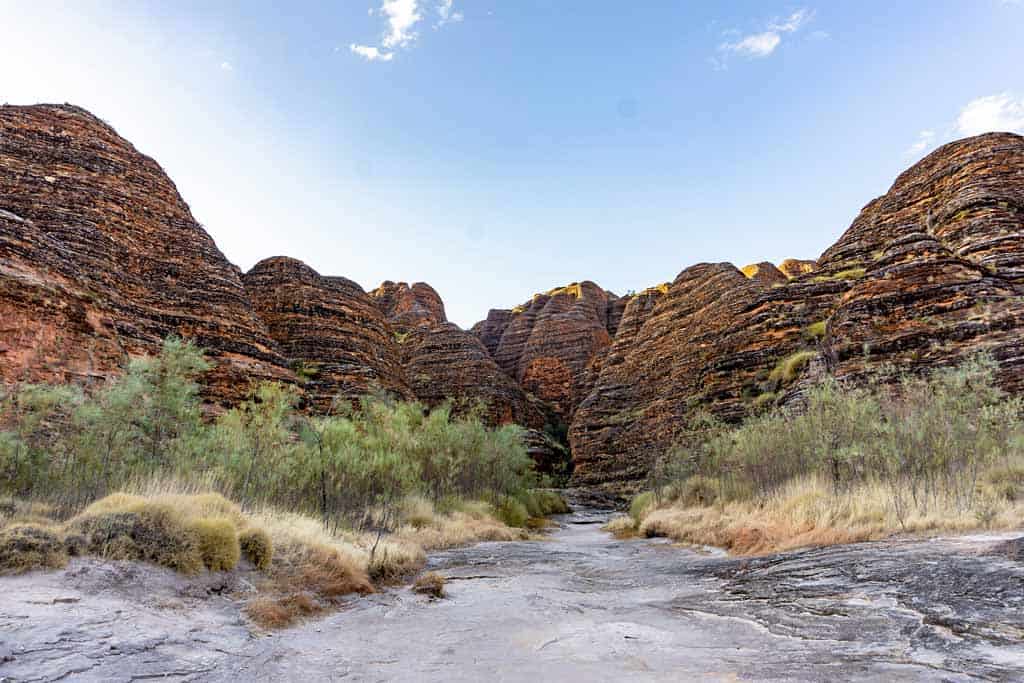 The Bungle Bungles
The Bungle Bungles
Travel Tips for your Northern Territory Road Trips
The Northern Territory is one of Australia’s more remote and beautiful states.
The area is rich with ancient rock art and Indigenous history, as well as breathtaking natural beauty.
To ensure your road trip is safe and enjoyable, make sure you are prepared!
Important Note! Before you book any international trip, we honestly recommend getting travel insurance. You never know when things will go wrong, and medical bills can add up quickly if you get sick or injure yourself overseas.
Our personal recommendation based on our own experience is World Nomads.
Always remember to fuel up
Some parts of the Outback are sparsely populated. You can drive for hundreds of kilometres without seeing any homes, businesses, or petrol stations.
So it’s super important to always fuel up your vehicle whenever you have a chance. It doesn’t hurt to have extra fuel stored in your car as well, just in case.
You don’t want to wait too long in between fuel stops! There is basically no worse place to be stranded without fuel than in the middle of the Australian desert.
Read next: The Ultimate Guide To Transportation In Australia
Avoid the wet season
Road trips in the Northern Territory should always avoid the wet season (December – March).
Especially in the Top End, where thundering waterfalls are scattered all over the landscape, the wet season can lead to floods and road closures.
So plan your road trip for the dry season!
While the summer months are wet in the Top End, they are also exceptionally hot in the desert. Places like Uluru, Kings Canyon, and Alice Springs are much more pleasant in the cooler winter months. So plan your road trip according to the seasons for the best experience.
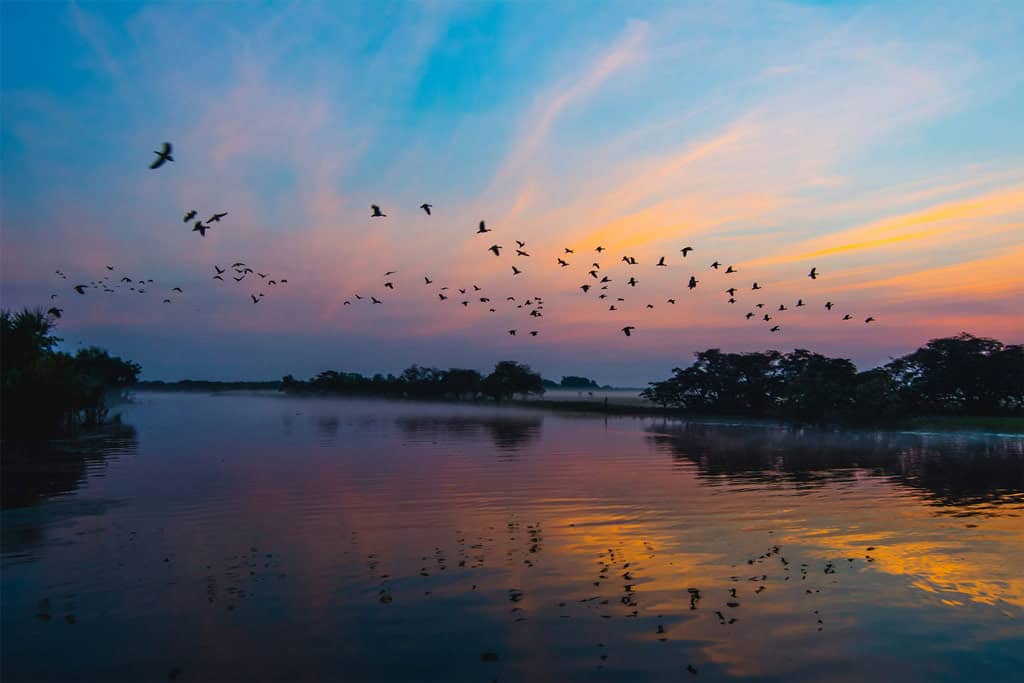 The wetlands of Kakadu and the Top End are inaccessible in the wet season!
The wetlands of Kakadu and the Top End are inaccessible in the wet season!
Research your accommodation options
Most road trips around the Northern Territory will be a few days or longer. The state is massive, and highlights tend to be very spread out. So unless you’re just doing a quick day road trip to somewhere near Darwin or Alice Springs, you’ll need to make sure you organise accommodation!
Most places in the Northern Territory aren’t as touristy as other parts of Australia like Queensland or New South Wales. So accommodations don’t fill up as quickly.
However, some small Outback towns have fewer accommodation options. You really don’t want to show up at a hotel and find there is no availability, so definitely book your stays in advance!
In a big city centre like Darwin, you should have no problem finding a hotel to start your road trip.
For smaller towns, I would recommend calling at least a few days ahead to book a stay. You can also research free campsites and caravan parks around the Northern Territory.
DISCLAIMER: Some of the links in this article are affiliate links, which means if you book accommodation, tours or buy a product, we will receive a small commission at no extra cost to you. These commissions help us keep creating more free travel content to help people plan their holidays and adventures. We only recommend the best accommodations, tours and products that ourselves or our fantastic editorial team have personally experienced, and regularly review these. Thanks for your support, kind friend!
